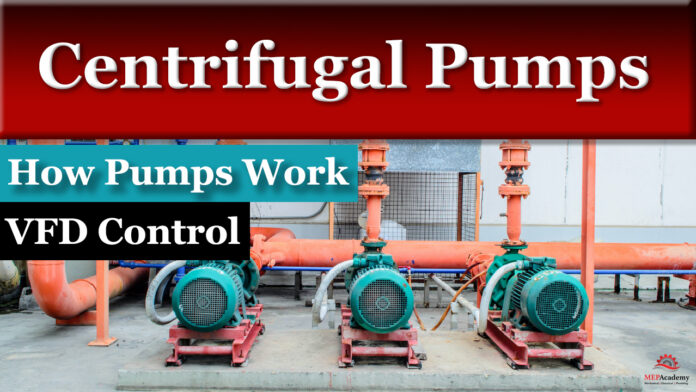We’ll learn centrifugal pump basics and how they work with VFD’s in HVAC Systems.
Scroll to the bottom to watch the YouTube video of this presentation.
The pump is made to put energy into water by increasing the pressure or flow. The energy is transferred from the motor to the shaft then to the impellor and the water. The centrifugal force causes the water to fly outward from the impellor.
Remember according to the first law of thermodynamics, energy can’t be created or destroyed but only transferred from one location to another or converted to and from other forms of energy.
There are many factors in the proper operation of a centrifugal pump system, including the quantity or GPM (LPS) of fluid flow, piping design and layout, method of control, and the selection of the pump.
As the head decreases, the flow rate will increase, and vice verses, if the head increases, the flow rate will decrease. Pump charts are based around these two factors, flow rate and head. See our video on How to Read Pump Charts.
Variable Frequency Drive (VFD) Pump Control
We can change the volume by speeding up or slowing down the motor using a variable frequency drive (VFD). We do this to match the load and save energy. No need for the pump to run at full speed if all that flow or GPM is not required by the air handlers or fan coils.
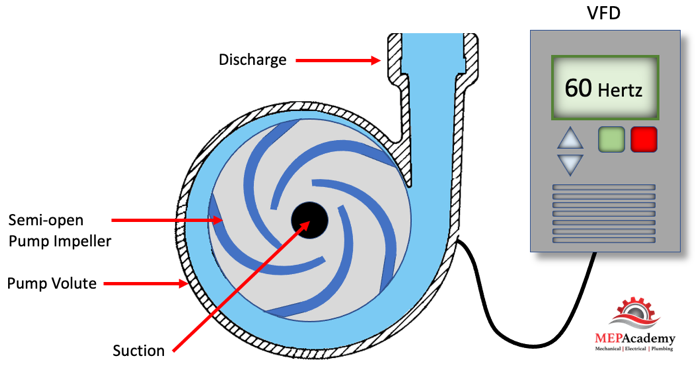
Most existing systems requiring flow control make use of bypass lines, throttling valves, or pump speed adjustments. The most efficient of these is pump speed control. When a pump’s speed is reduced, less energy is imparted to the fluid and less energy needs to be throttled or bypassed. Speed can be controlled in a number of ways, with the most popular type of variable speed drive (VSD) being the variable frequency drive (VFD).
A differential Pressure Transmitter will send a signal to the VFD controlling the pump to either speed up or slow down based on the demand of the system.
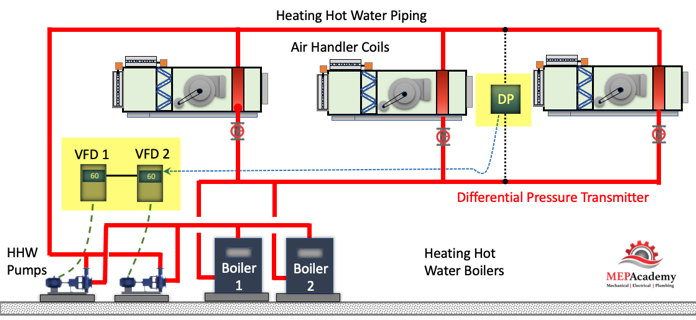
What does a HVAC Centrifugal Pump Look Like?
There are many manufacturers that make centrifugal pumps for the HVAC industry, but basically, they all function the same way and with the same purpose in mind, and that is to move a fluid through pipes and equipment while overcoming the friction. All though the colors may vary by manufacture the parts are similar.

Centrifugal pumps have few moving parts with minimal wear during normal operations. There are two main components, the motor which drives the pump, and the pump which contains the impellor, the propulsion vanes that pull and push the fluid. The motor takes electrical power and converts it into mechanical energy that moves the fluid through the pipe and equipment. The pump has an inlet where it sucks in the fluid and an outlet where it pushes the fluid out through the system.
Parts of a Centrifugal Pump
Pumps are relatively a simple piece of equipment when compared to other HVAC equipment. Starting with the motor we have the motor casing which is rated for various duties, such as Open Drip Proof (ODP), Totally Enclosed Fan Cooled (TEFC). Motors can also be inverter duty rated so that a Variable Frequency Drive (VFD) can vary the speed of the motor to match the load.
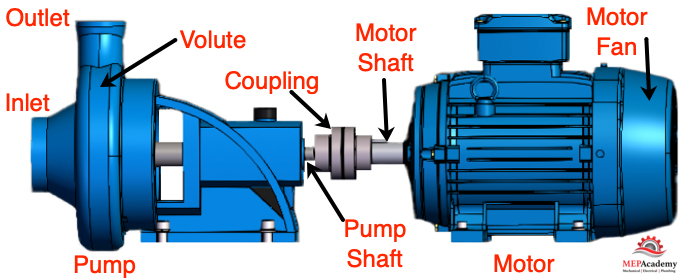
The motor has a shaft that extends into the pump portion where it attaches to the impeller, this can be a direct connection or by a coupling. The impeller is made up of vanes that rotate to impart energy to the water. The spinning vanes create a centrifugal force throwing the water from the rotating impeller. The water discharged by the impeller is thrown by centrifugal force into the spiral-shaped volute which is the housing surrounding the impeller.
Pumps are available with various impeller sizes; each size provides a different amount of flow and head. The pump may come with the option of an 7″, 7-1/2″, 8”, 8-1/2″, 9”, and 9-1/2″” impeller.
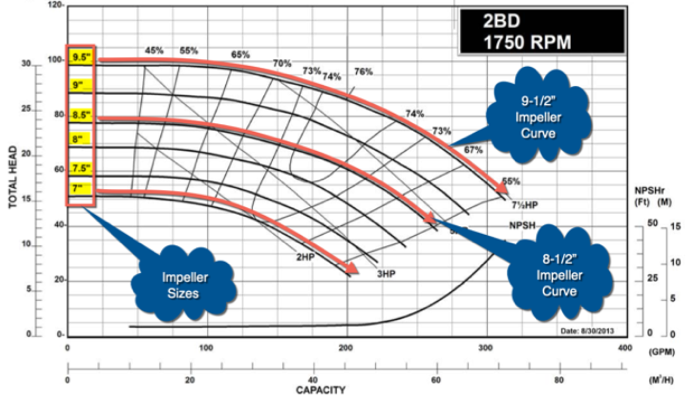
To change the flow rate of an existing pump you can trim the impeller to make it smaller or replace the impeller with a larger one if the pump isn’t already using the largest impeller for that pump model.
Disassembling the pump, we see that the motor has a fan to keep it cool when running. The motor converts electrical energy into mechanical energy and spins the shaft. See our video on how Motors Work. Attached to the shaft is an impeller which is housed inside a Volute, the protective casing surrounding the impeller, and which acts as a guide for the water being forced out of the impeller by the spinning centrifugal force.
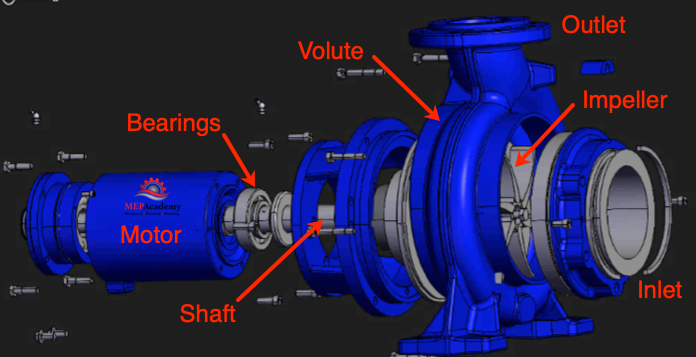
Some shafts extend all the way from the motor through the impeller, while other pumps use a coupling to match up the motor shaft with the impeller/pump shaft. Two separate shafts meeting with a coupling that attaches them together.
The shaft passes into the pump casing and is usually made of stainless steel or high carbon steel. The shaft is support by bearings.
Impellers come in various configurations including closed, semi-open and open. The impeller shown here is of the semi-open type, which means it has as shroud on the back side only.

If you missed our previous video on Pump Charts, check that video out to see how Impellers are chosen to meet system design conditions.
The outer casing of the pump is called the volute and directs the water exiting the impeller to the outlet.
The stuffing box contains either a mechanical seal or packing to prevent the leakage of water from around the shaft. The packing is made of fiber and lubricated with graphite or Teflon.
With the impeller surrounded by water, and the impeller rotating, the water gets thrown outwards in all directions. The water leaving the impeller encounters the volute, while creating a lower pressure region at the suction inlet where more water is sucked in.
The discharge pressure will be higher than the suction pressure, causing the fluid to flow around the system.
Cavitation
Cavitation occurs when vapor bubbles appear due to the liquid falling below its vapor pressure. When the pressure at the inlet of the pump drops below the vapor pressure of the water, bubbles will begin to appear around the eye of the impeller. Then when these bubbles encounter a pressure above the vapor pressure of the water, the bubbles will collapse causing a crackling noise, vibration, and shock waves that can damage the surface of the impeller.
Where are Centrifugal Pumps used?
Centrifugal pumps are used mostly in the commercial HVAC industry to move chilled water, heating hot water and condenser water.
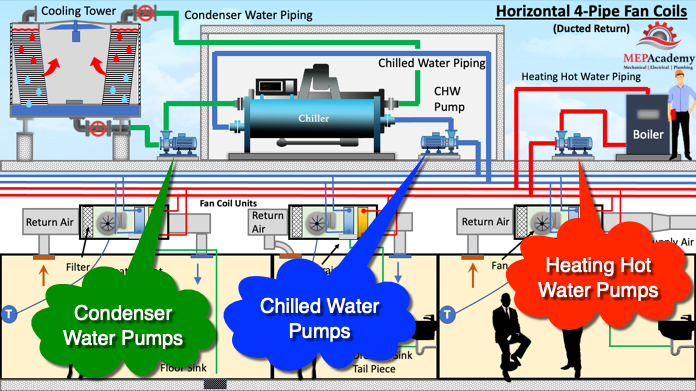
There are chilled water and heating water systems that may be comprised of primary and secondary pumps. Condenser water system that feed a cooling tower or a water-cooled heat pump system.
Small vertical inline pumps can be used in residential projects for domestic hot water recirculation and snow melt systems.
Pump Configurations
Centrifugal pumps can be provided in various configurations from end suction, split-case and vertical turbines. The most common in the HVAC industry is the end suction pump which has the inlet centered on the eye of the impeller. They are classified as either close-coupled or frame mounted.


